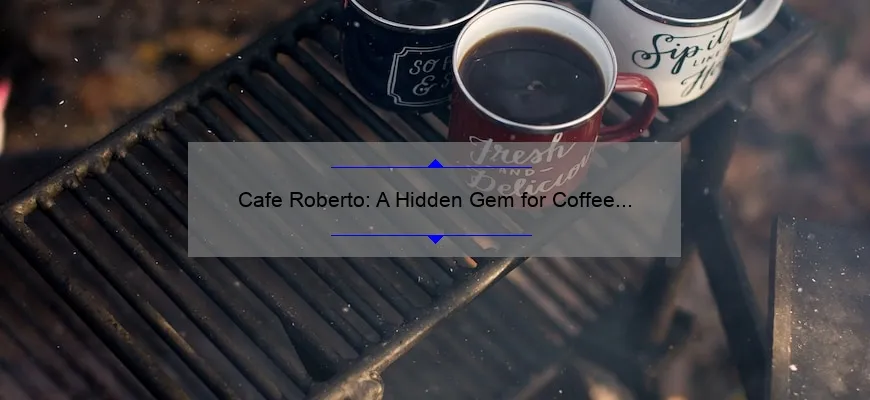- Short Answer: Café au
- The Origins of Café au Lait: Unraveling the Rich History and Cultural Significance
- How to Brew the Perfect Café au Lait at Home: A Step-by-Step Guide for Coffee Enthusiasts
- Café au Lait vs Latte: Decoding the Differences and Distinctions
- Frequently Asked Questions About Café au Lait: Your Ultimate Guide to Common Inquiries
- Mastering Milk Frothing Techniques for a Creamy Café au Lait Experience
- Exploring Regional Variations of Café au Lait: From Parisian Cafés to Global Coffee Culture
Short Answer: Café au
Café au is a traditional French coffee beverage made by combining equal parts of strong, dark roast coffee and hot milk. It is often served in a bowl or mug and can be enjoyed plain or sweetened with sugar. This drink became popular in France during the 18th century and continues to be a beloved choice for coffee enthusiasts worldwide.
The Origins of Café au Lait: Unraveling the Rich History and Cultural Significance
Café au Lait is more than just a delicious and comforting coffee beverage; it carries with it a rich history and cultural significance that makes every sip all the more enjoyable. In this blog post, we will delve into the origins of Café au Lait, tracing its roots back to its birthplace and exploring how it has evolved over time.
The story of Café au Lait starts in the vibrant streets of Paris, France during the 17th century. The French, renowned for their passion for gastronomy, were experimenting with new ways to prepare and enjoy coffee. It was during this period that Café au Lait emerged as a delightful combination of strong coffee mixed with hot milk.
The term “Café au Lait” literally translates to “coffee with milk” in French, but don’t be fooled by its simplicity. The artistry lies in finding the perfect balance between coffee and milk—a delicate dance that results in a harmonious blend of flavors.
What sets Café au Lait apart from other coffee beverages is its unique preparation method. Unlike traditional methods where milk is added after brewing the coffee, Café au Lait involves adding hot milk directly to brewed coffee. This method ensures that both elements meld together seamlessly, creating a velvety smooth texture and enhancing the overall taste experience.
Beyond its exquisite flavor profile, Café au Lait holds great cultural significance across different regions around the world. In France, it is an integral part of breakfast culture—a staple that accompanies flaky croissants or buttery pain au chocolat. This pairing symbolizes comfort and indulgence at the start of each day.
In recent years, Café au Lait has gained popularity beyond continental Europe and has become a favorite among coffee enthusiasts worldwide. From bustling cafés in New York City to quaint streetside bistros in Melbourne, people have fallen in love with this elegant mix of contrasting flavors.
What makes Café au Lait even more special is its versatility. The basic recipe allows for countless variations, making it adaptable to individual tastes and preferences. For those seeking a bolder experience, a shot of espresso can be added for an extra caffeine kick. On the other hand, those looking for a sweeter alternative can opt for flavored syrups or spices such as cinnamon or vanilla.
Café au Lait also serves as a canvas for latte art—a practice where baristas use steamed milk to create intricate designs on the surface of the coffee. From delicate hearts to elaborate flower patterns, latte art adds an element of visual appeal and showcases the skill and creativity of the barista.
As we sip on our Café au Lait, let us take a moment to appreciate its rich history and cultural significance. It is not just a caffeinated beverage; it is a testament to human ingenuity in finding harmony between contrasting elements. So next time you order a Café au Lait, remember that you are partaking in a timeless tradition that transcends borders and brings people together through the joy of coffee.
How to Brew the Perfect Café au Lait at Home: A Step-by-Step Guide for Coffee Enthusiasts
Title: Mastering the Art of Brewing the Perfect Café au Lait at Home
Introduction:
For coffee enthusiasts, there is nothing quite as satisfying as starting your day with a rich and creamy café au lait. This French classic combines the bold flavors of coffee with velvety steamed milk, creating a harmonious symphony for your taste buds. While enjoying this delightful beverage at a cozy café is always a treat, why not learn to master the art of brewing it in the comfort of your own kitchen? In this step-by-step guide, we will take you on an aromatic journey towards crafting the perfect café au lait.
Step 1: Selecting Your Coffee Beans
To lay the foundation for a divine café au lait, it all begins with selecting high-quality coffee beans. Opt for medium-to-dark roasted beans that showcase notes of sweetness and nuttiness while maintaining their bold flavor profile. Arabica beans are ideal, as they offer a pleasant acidity and complex flavors that complement creamy undertones.
Step 2: Grind Like A Pro
Invest in a reliable burr grinder to ensure consistency in particle size – an essential aspect when aiming for optimal extraction. For café au lait, aim for a medium-fine grind resembling kosher salt. This consistency strikes the right balance between extracting flavors without over-extracting bitter compounds.
Step 3: Water Matters
Using filtered water at around 200°F (93°C) helps extract the full potential of those carefully selected coffee grounds while keeping unwanted minerals at bay. Avoid using tap water which can introduce unpleasant tastes and possibly affect your brew’s quality.
Step 4: Brew Time and Technique
Prepare yourself to embrace either manual methods or modern marvels like espresso machines or automatic drip brewers with espresso capabilities. The key lies in achieving a rich espresso shot that serves as the base for our heavenly concoction.
– Manual Method (French Press): Place the desired amount of coffee grounds into your French press, pour hot water over them, and let steep for about 4 minutes. Once brewed, press down on the plunger to separate the liquid from the grounds.
– Espresso Machine: If you own an espresso machine, dose your finely ground coffee into the portafilter, gently tamp it down, lock it in place, and pull a rich shot.
– Automatic Drip Brewer (with Espresso Capabilities): If utilizing one of these machines, check your manufacturer’s instructions for brewing techniques specific to espresso.
Step 5: Frothing the Milk
Now comes the magical part – frothing milk that will elevate your café au lait to new heights. For a velvety texture and creamy mouthfeel, opt for whole or 2% milk. Fill a stainless-steel pitcher about halfway with cold milk and submerge a steam wand just below its surface at an angle. Turn on full steam until small bubbles emerge; then lower and tilt the pitcher while keeping it spinning clockwise slowly. Aim to achieve glossy microfoam with no large bubbles.
Step 6: Combining Flavors
Fill half of a large cup or mug with your freshly brewed espresso shot, ensuring there is enough space for milk. Slowly pour steamed milk into the cup while maintaining control over the flow rate—aiming for equal parts coffee to milk ratio. A delicate pour helps create beautiful latte art if desired, showcasing your brewing prowess!
Step 7: Experiment & Garnish
Café au lait often carries flavors like vanilla or cinnamon gracefully. Feel free to add syrups or spices to create various flavor profiles based on personal preference.
For an added touch of elegance, consider dusting some cocoa powder or cinnamon atop your masterpiece —a visually appealing garnish will delight both you and those lucky enough to savor this divine brew.
Conclusion:
With this comprehensive guide, you are now equipped to brew the perfect café au lait at home. By selecting quality beans, mastering your brewing technique, and showcasing your artistic touch in cup design or flavor experiments, you can create a truly extraordinary experience. So go ahead, turn your kitchen into a coffee haven and indulge in the ultimate pleasure of a perfectly brewed café au lait – an ode to French coffee heritage.
Café au Lait vs Latte: Decoding the Differences and Distinctions
Café au Lait vs Latte: Decoding the Differences and Distinctions
When it comes to indulging in a warm, creamy coffee beverage, two options often come to mind: café au lait and latte. While they may appear similar at first glance, there are actually some significant differences and distinctions between these two beloved drinks. So, let’s embark on a journey of unraveling the mysteries behind café au lait and latte!
Firstly, let’s understand the origins of these delightful concoctions. Café au lait hails from France, where it has been enjoyed for centuries. The name itself translates to “coffee with milk,” which perfectly describes its essence. On the other hand, the latte is an Italian creation that emerged during the wave of espresso culture in Europe.
One fundamental distinction lies in their preparation methods. To make a classic café au lait, equal parts brewed coffee and steamed milk are combined directly in the cup. This simplicity ensures that both elements meld harmoniously to create a balanced flavor profile. On the contrary, crafting a latte involves extracting shots of espresso and then pouring steamed milk over them in careful layers—a true art form! Latte artists take pleasure in mastering beautiful patterns on top of their creations.
Another notable difference lies within their ratios of coffee to milk. In café au lait, these components hold equal importance as they share an equal volume within the cup. This traditional approach allows for more prominence of coffee flavors while still retaining a smooth texture from milky goodness. Meanwhile, lattes put emphasis on showcasing espresso by using just one or maybe two shots per serving—depending on your preference—and then complementing those bold flavors with a lush blanket of frothed or steamed milk.
Furthermore, when it comes to taste profiles and strengths, each drink has its own unique characteristics. Café au lait tends to have a milder and smoother flavor, striking a chord with those who prefer a gentler coffee taste. The use of brewed coffee provides a subtle roasted note that pairs perfectly with the creamy milk to create a cozy and comforting beverage.
For those seeking a bolder caffeine kick and robust espresso flavors, the latte always comes to the rescue. The concentrated nature of espresso creates a stronger foundation for delightful undertones that stir your taste buds. Balancing this strength is the velvety texture of steamed milk, resulting in a drink that offers both power and smoothness—a true indulgence for coffee aficionados!
But wait, there’s more! One last crucial difference lies in their cultural significance and consumption practices. While café au lait represents an integral part of French café culture, it is typically enjoyed in the morning alongside breakfast or as an afternoon treat with pastries. In contrast, lattes have gained widespread popularity worldwide as they offer versatile customization options—thanks to flavored syrups—and can be savored at any time throughout the day.
So there you have it—the elaborate decoding of the differences and distinctions between café au lait and latte. Whether you prefer the gentle elegance of café au lait or crave the bold complexity of lattes, both options provide their own unique experiences for coffee lovers everywhere. Next time you find yourself at your favorite café, armed with newfound knowledge, make an informed decision and enjoy every sip!
Frequently Asked Questions About Café au Lait: Your Ultimate Guide to Common Inquiries
Welcome to our ultimate guide to answering all your frequently asked questions about Café au Lait! Whether you’re a coffee aficionado or just curious about this delightful beverage, we’ve got you covered. Sit back, relax, and allow us to clear up any inquiries you may have.
1. What is Café au Lait?
Café au Lait, which translates to “coffee with milk” in French, is a classic beverage that combines equal parts of brewed coffee and hot milk. Unlike popular coffee variations like lattes or cappuccinos, Café au Lait incorporates steamed milk instead of frothed milk. This results in a creamy yet smooth drink that highlights the natural flavors of the coffee.
2. How is it different from other coffee drinks?
Café au Lait stands out from other coffee drinks due to its simplicity and focus on balanced flavors. While espresso-based beverages utilize shots of concentrated coffee, Café au Lait uses regular brewed coffee as its base. Additionally, unlike a latte or cappuccino which have more foam on top, Café au Lait features mostly steamed milk evenly mixed with the same amount of brewed coffee.
3. Can I make Café au Lait at home?
Absolutely! Making Café au Lait at home is incredibly simple and doesn’t require any fancy equipment. All you need is freshly brewed coffee and steamed milk. For best results, use a medium roast coffee with well-balanced flavors that complement the milk.
4. Which type of milk should I use?
Traditionally, whole cow’s milk was used for Café au Lait due to its rich taste and ability to create a velvety texture when steamed. However, nowadays many people prefer alternative milks such as almond, oat, or soy for dietary or personal preference reasons. Choose whichever milk suits your taste buds best!
5. Is there room for customization?
Certainly! One of the fantastic aspects of Café au Lait is its versatile nature. You can add a hint of sweetness by incorporating flavored syrups like vanilla, caramel, or hazelnut. For a touch of indulgence, top it off with whipped cream or sprinkle some cocoa powder on the foam. The possibilities are endless!
6. Can I drink Café au Lait at any time during the day?
Absolutely! Unlike other coffee varieties that are commonly associated with specific times of the day, Café au Lait can be enjoyed at any hour. Whether you prefer it as your morning pick-me-up, an afternoon treat, or even as an after-dinner delight, this timeless beverage is always a good idea.
7. Are there any health benefits to drinking Café au Lait?
While moderation is key for all caffeinated beverages, Café au Lait does offer potential health benefits. Coffee consumption has been linked to increased alertness and improved cognitive function due to its caffeine content. Moreover, milk provides essential nutrients like calcium and protein which contribute to strong bones and muscles.
8. How can I order Café au Lait in a café?
Ordering Café au Lait is straightforward! Simply ask for “Café au Lait” at your favorite café or coffee shop. Baristas will understand what you mean and serve you this classic beverage just the way you like it – hot and harmoniously blended.
So there you have it – our ultimate guide to answering all your frequently asked questions about Café au Lait! We hope this comprehensive explanation has satisfied your curiosity and inspired you to indulge in this delicious coffee delight. Whether you’re sipping it at home or ordering it from a café, may every cup of Café au Lait brighten your day with its creamy goodness!
Mastering Milk Frothing Techniques for a Creamy Café au Lait Experience
Welcome, coffee lovers! Today, we embark on a journey to uncover the secrets behind mastering milk frothing techniques for a creamy Café au Lait experience. Whether you are an aspiring barista or a coffee enthusiast looking to enhance your home brewing skills, this blog is designed to equip you with the knowledge and techniques necessary to achieve that perfect velvety microfoam atop your favorite cup of java.
To begin our exploration, let’s first understand the importance of milk frothing in creating the ultimate café au lait. A traditional café au lait is a delightful blend of strong brewed coffee and steamed milk. The key lies in achieving the ideal texture and consistency of the milk foam which adds both creaminess and visual appeal to every sip.
The process starts with selecting the right type of milk. Whole milk tends to yield the best results due to its higher fat content, producing richer foam and lending a more indulgent mouthfeel. However, if you prefer a lighter alternative, skim or low-fat milk can also be used with slightly adjusted techniques.
Now comes the artistry involved in steaming and frothing your chosen milk variety. It all begins with an impeccably clean stainless-steel pitcher – no remnants of previous brews allowed! Pour your desired amount of cold milk into the pitcher, keeping in mind that it will expand as air bubbles are introduced during the frothing process.
Next up is positioning your steam wand correctly. Aim for submerging it just below the surface of the milk without touching the bottom or sides of your pitcher. Begin by opening the steam valve partially until you hear that sweet hissing sound indicating steam being released.
Here comes one pro tip: always purge any excess moisture from your steam wand before placing it into fresh cold milk. This prevents unwanted splattering and ensures clean steaming from start to finish.
Gently lower the steam wand into your pitcher at an angle (approximately 30 degrees) and focus on creating small whirlpool-like movements. This technique allows for even distribution of heat, resulting in uniform frothing.
Now, here’s where it gets interesting – the magical process of aeration. Gradually lower the steam wand further into the milk while simultaneously raising the pitcher slightly to maintain a constant depth between the tip of the wand and the milk surface. This action introduces air into the milk, creating those beautiful microfoam bubbles we all adore.
Timing is crucial when mastering milk frothing techniques. Aim to achieve your desired level of foaminess within 10-15 seconds. Be attentive, for every second counts! You’ll know you’ve reached perfection when your microfoam appears glossy with tiny, evenly distributed bubbles dancing on its surface.
Once your frothing masterpiece is complete, remove any excess bubbles by gently tapping or swirling the pitcher against a countertop. Remember, our goal is velvety texture rather than large airy bubbles that may disrupt our café au lait experience.
Congratulations! You are now equipped with insider knowledge to master milk frothing techniques like a true maestro barista. Whether you’re aiming for intricate latte art or simply enhancing your everyday coffee indulgence, these skills will undoubtedly elevate your café au lait game to new heights.
So go forth and experiment with different types of milk, steam wand angles, and frothing durations until you find that perfect balance. Your taste buds deserve nothing less than an exquisitely creamy café au lait experience crafted with precision and passion!
Happy brewing!
Exploring Regional Variations of Café au Lait: From Parisian Cafés to Global Coffee Culture
In the bustling streets of Paris, amid the aroma of freshly baked croissants and the clinking of coffee cups, one can find a cherished beverage that represents the essence of French café culture – Café au Lait. This classic French drink has become an international staple, transcending borders and embracing regional variations around the world. Join us on a delightful journey as we explore the diverse interpretations of Café au Lait, from its birthplace in Parisian cafés to its integration into global coffee culture.
At its core, Café au Lait is a simple and harmonious blend of coffee and hot milk. However, each region has put its own twist on this beloved beverage, resulting in unique flavors and techniques that reflect local tastes and customs.
Starting with its birthplace in Parisian cafés, Café au Lait holds a special place in the hearts of locals and visitors alike. The French take great pride in their café culture, which revolves around leisurely sipping coffee while engaging in lively conversations or people-watching on quaint terraces. In Paris, Café au Lait is traditionally served alongside a flaky croissant or buttery brioche for an indulgent morning treat. The coffee used is often a dark roast with robust flavors that stand up well to the silky smoothness of steamed milk.
Venturing outside France’s borders, we encounter regional variations that have honorably assimilated Cafe au Lait into different cultures worldwide. In Italy, for instance, they have their own interpretation called “Caffè Latte.” Italians are known for their intense espresso shots; however, they also appreciate a milder option at breakfast time. Thus came about Caffè Latte: an expertly brewed espresso shot topped with an equal amount of steamed milk poured ever so delicately to create beautiful latte art – a visual testament to their dedication to craftsmanship.
Across the Atlantic Ocean lies another variation known as “Café con Leche” originating from the passionate coffee culture of Spain and Latin America. The bold and vibrant flavors of Cuban, Colombian, or Mexican coffee beans meld seamlessly with the creamy richness of steamed milk. Often enjoyed as a mid-morning pick-me-up, Café con Leche is both comforting and invigorating, reflecting the warmth and lively spirit ingrained in these cultures.
As we continue our exploration towards the far corners of the globe, we encounter yet more intriguing versions of Café au Lait. In Australia, known for its strong coffee tradition and fervent café scene, they have embraced this French classic with open arms under the name “Flat White.” This down-under delight boasts an intense espresso shot topped with velvety microfoam milk that blends effortlessly through the coffee – producing a rich yet subtle flavor profile loved by many.
In Japan, where precision and attention to detail are paramount in every aspect of life including food and drink preparation, “Kohi-Atto” takes center stage. While inspired by European coffee culture, Kohi-Atto showcases Japanese minimalism and artistry through meticulous brewing methods paired with delicate latte art. A harmonious balance between smoothness and intensity is achieved as equal parts gently roasted coffee are combined with perfectly steamed milk to create a visually stunning work of art.
Beyond these highlights lies a world filled with countless regional variations of Café au Lait that pay homage to individual cultural nuances while celebrating the universal pleasure found in a well-crafted cup of coffee. From South Africa’s creamy “koffie verkeerd” to Portugal’s bold “Galão,” each adaptation carries its own story – one that intertwines heritage, innovation, and personal preferences into every sip.
So whether you find yourself strolling through Parisian streets yearning for an authentic Café au Lait experience or venturing into new lands where local interpretations reign supreme; take a moment to savor the rich tapestry of flavors and traditions that have contributed to the global coffee culture we know today. Celebrate the countless regional variations of Café au Lait, each one honoring its roots while embracing the ever-evolving nature of this beloved beverage.








